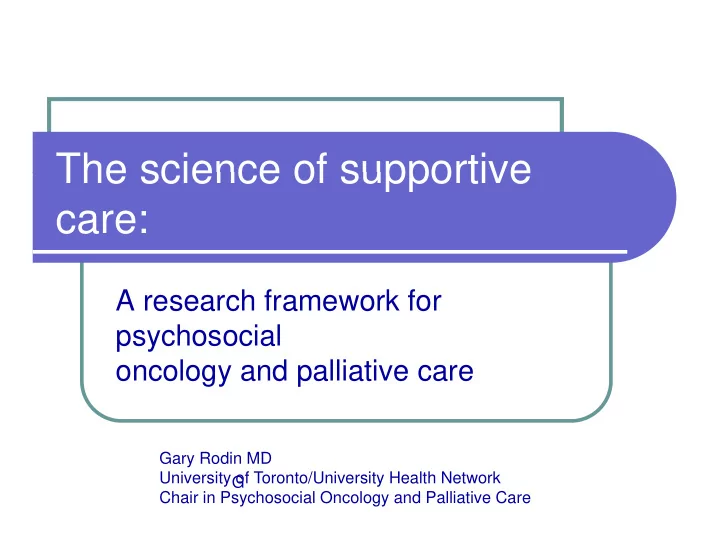

The science of supportive The science of supportive care: A research framework for psychosocial oncology and palliative care gy p G Gary Rodin MD R di MD University of Toronto/University Health Network G Chair in Psychosocial Oncology and Palliative Care
The Short (and long) history of Palliative Care Palliative Care
Longitudinal & Integrated Cancer Care & Integrated Cancer Care Palliative Care Cancer Cancer Supportive Care Risk Risk anti anti- -cancer cancer grief & grief & grief & grief & treatments treatments Diagnosis Diagnosis bereavement bereavement Psychosocial Oncology
Diagnosis Diagnosis Genetic Genetic Decision Decision- -Making Making Risk Risk Locally Locally Treatment Treatment Advanced Advanced Advanced Advanced R Re Re- -Entry & E t Entry & E t & & Disease Disease Recurrence Recurrence Survivorship Survivorship Progression Progression Advanced Disease Advanced Disease End of Life End of Life Bereavement Bereavement
The Rise of Research in Palliative Care Care 16000 14000 12000 10000 8000 6000 6000 4000 2000 0 1950-59 1960-69 1970-79 1980-89 1990-99 2000-07
Unproven Beliefs in Palliative and Supportive Care Care � Psychosocial and symptomatic outcomes t ti t improved by: � Routine distress screening screening � Early palliative acre � Routine bereavement counseling counseling � Psychosocial interventions prolong survival � Psychostimulants are effective for the treatment of depression p
Has the Revolution of Palliative & Supportive Care Changed Medical Practice? Changed Medical Practice? � Pain � 50% of patients who died in hospital report moderate to severe pain 50% f ti t h di d i h it l t d t t i � SUPPORT � Depression o y only 1/3 of patients with MDD attending a UK cancer center /3 o pa e s a e d g a U ca ce ce e � received any potentially effective RX � Sharpe et et al, 2004 � End of Life � 18 5% of cancer patients receive chemotherapy in the last two weeks � 18.5% of cancer patients receive chemotherapy in the last two weeks of life � Earle et al 2004 � <30% referred to palliative care � SUPPORT � SUPPORT � Communication � Severe communication problems reported by up to 40% of patients at the EOL in UK, Ireland and Italy � Higginson et al, 2002 Hi i t l 2002
The Domains of Research • Distress • Needs • Meaning M i • Communication • Planning the end • Planning the end • The “good death” • Bereavement Bereavement
Why Has Competence and Research in Palliative Care Been Slow to Develop Palliative Care Been Slow to Develop � Curative model of medicine � Curative model of medicine � Teaching and research in acute care settings � Professional incentives for active treatment � Professional incentives for active treatment � Medical education � Nonacademic tradition of palliative care � Nonacademic tradition of palliative care � Interdisciplinary requirements � The complexity of the problems addressed � The complexity of the problems addressed
Methodological and Practical Challenges of Research in Palliative and Supportive Care Research in Palliative and Supportive Care � Recruitment & informed consent n vulnerable populations � Valid and reliable measures � Proxy measures � Retrospective reports � Fragmentation of health care F t ti f h lth � Lack of system-wide database � Predictably deteriorating course � Predictably deteriorating course � Multiple interacting risk factors � Complexity of the problems p y p
The Problem of Measurement Demoralization Demoralization Marital/ Family Marital/ Family Existential Concerns Existential Concerns Existential Concerns Existential Concerns Functioning Functioning & Social Needs & Social Needs Depression Depression Anxiety Anxiety Anxiety Anxiety Spiritual Spiritual Pain Pain Wellbeing Wellbeing Wellbeing Wellbeing Desire for Desire for Death Death
The Cascade Effect of Multiple Risk & Protective Factors Factors Disease Burden Psychosocial Factors: Pain and Physical Distress Social Support Stage of Disease S f i Attachment Security Proximity to Death Self Esteem Spirituality & Religiosity Depression Hopelessness Desire For Hastened Death Desire For Hastened Death Rodin et al, Soc Sci Med, in press
Frequency of Specific Physical Symptoms in Patients with Metastatic GI and Lung Cancer Patients with Metastatic GI and Lung Cancer 100 80 80 60 % 40 20 0 0 Lack of Energy Pain Feeling Drowsy Difficulty Dry Mouth Problems in Changes in Sleeping Sexual taste Interest/Activity WTL Study
Prevalence of Depression, Hopelessness and the Desire for Hastened Death the Desire for Hastened Death 40 40 35 30 25 20 n=326 n=101 spouse 101 15 10 5 5 0 BDI>15 BHS>8 SAHD>9 J Pain & Symptom Mgmt, 2007 J Pain & Symptom Mgmt, 2007 Journal of Clinical Oncology, 2007
Informing a Informing a Bi Bi Bioethical Debate Bioethical Debate thi thi l D b t l D b t Right to Right to Right to Die Right to Die Palliative Palliative Care Care relief of suffering meaning in suffering support
Significant Predictors of Depression � Proximity to death y � Performance status � Severity and number of physical symptoms � Self esteem � Attachment anxiety � Attachment anxiety � Spiritual well-being � Hopelessness � Hopelessness Rodin et al Soc � Sci & Med, in press
Disease burden, psychosocial risk & time
The Future of Research in Palliative and Supportive Care Supportive Care Symptoms/ Symptoms/ Bi l Biology Biology Bi l P P Psychology Psychology h l h l Experience Clinical Course Course Social/ Social/ Health Relational Relational Relational Relational Care Care
Recommend
More recommend